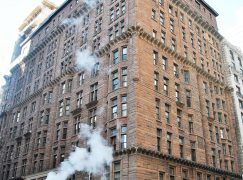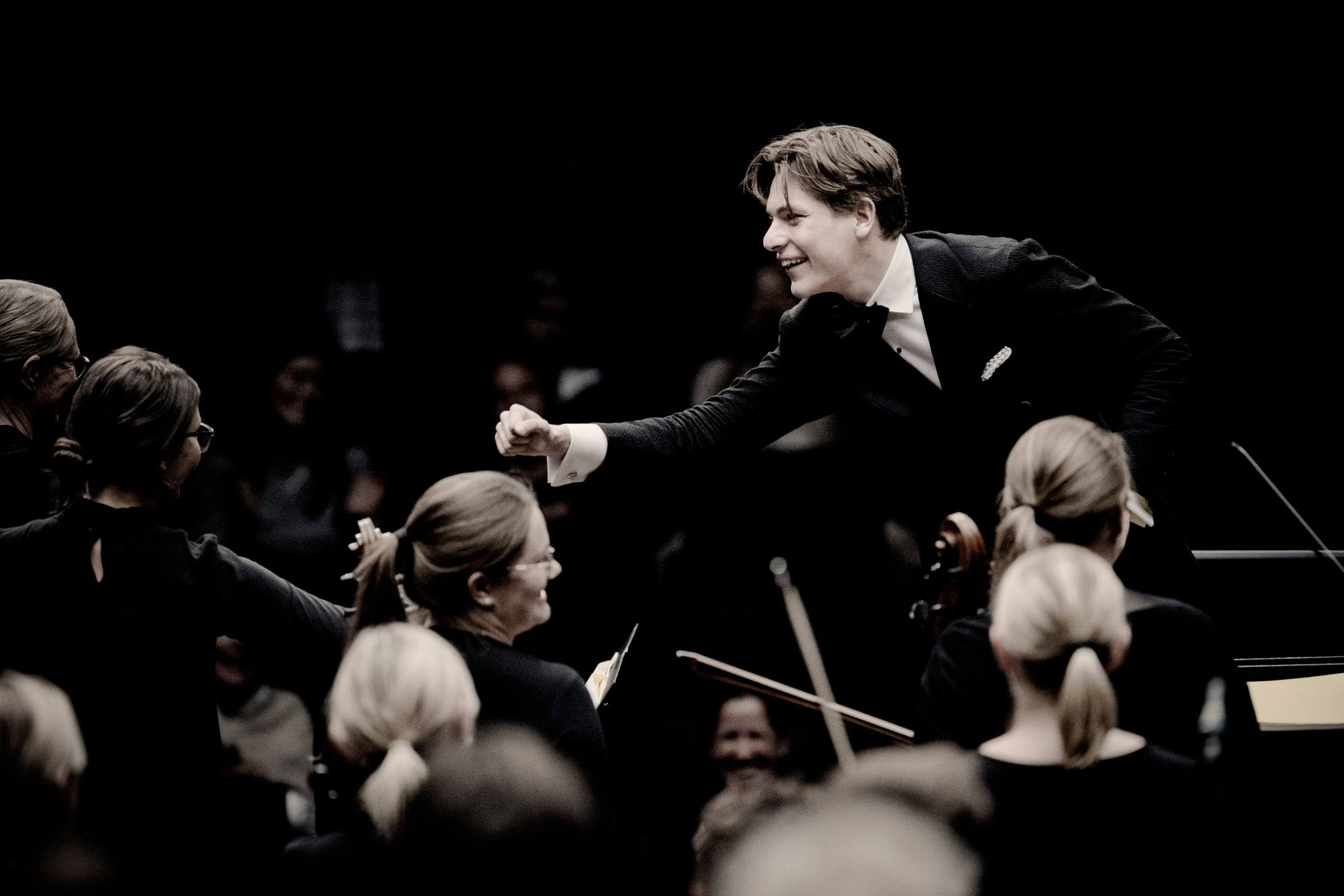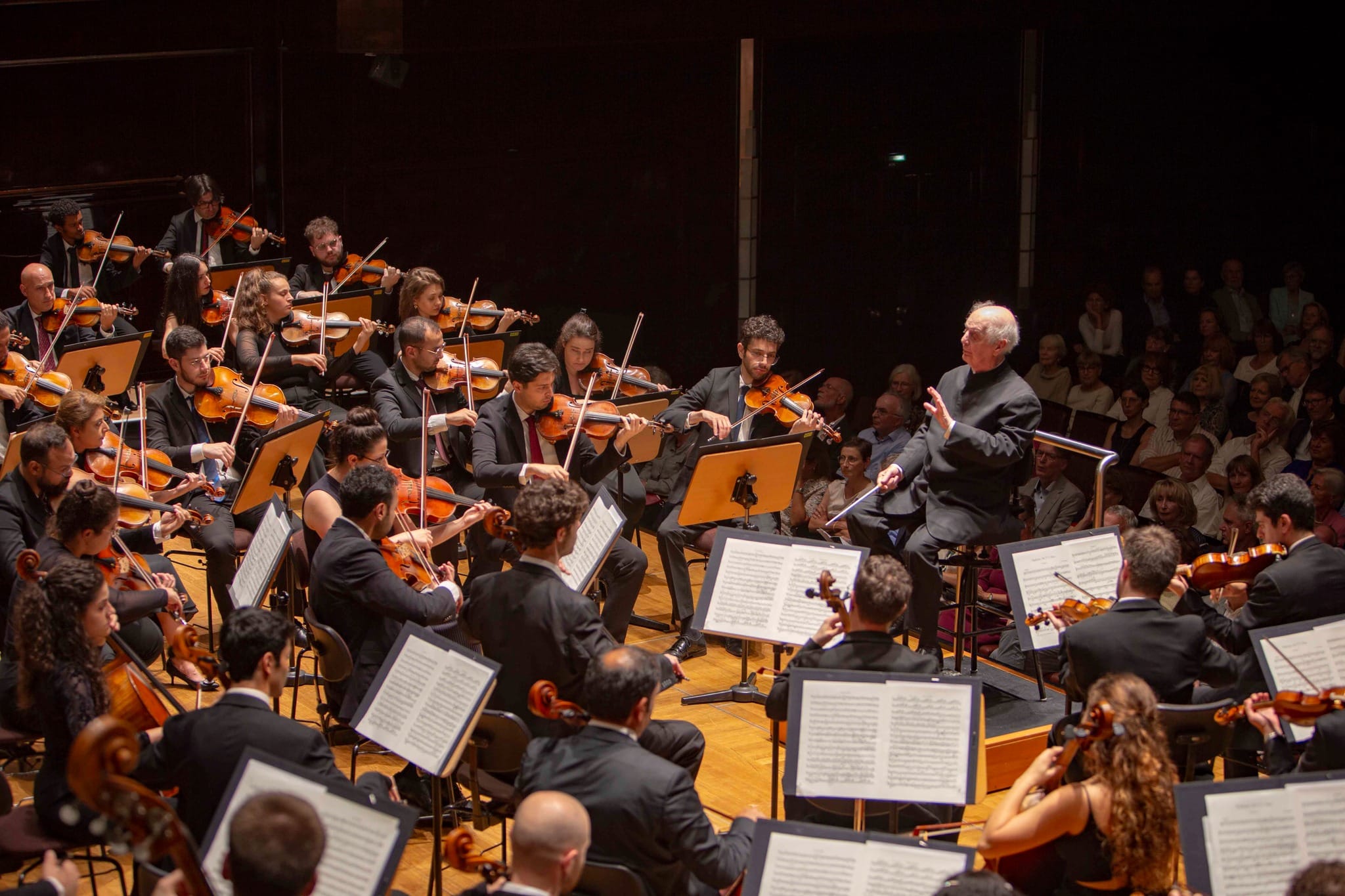| Leonard Bernstein, the great American composer of classical and Broadway music, conductor, and educator, was born on August 25, 1918, to Jewish immigrant parents in Lawrence, Massachusetts, and grew up in Boston. While studying music at Harvard, he met three of the musical figures who would have a great influence on his work and career – conductor Dimitri Mitropoulos and composers Aaron Copland (a life-long friend) and Marc Blitzstein. Bernstein had brief affairs with both Mitropoulos and Copland.
….
| Located diagonally across from Carnegie Hall (another LGBT historic site), the Osborne Apartments has long been a popular home for people in the arts. Other significant LGBT residents have included: |
|
- Bobby Short, legendary cabaret artist (who lived in Bernstein’s former apartment)
- Van Cliburn, pianist who won the inaugural International Tchaikovsky Piano Competition in Moscow in 1958, at 23
- Robert Osborne, actor and film historian best known for hosting prime-time films on Turner Classic Movies
|
- Leo Lerman, editor and writer, along with his partner, artist Gary Foy
- Fran Lebowitz, author
- Fernando Sanchez, fashion designer best known for his provocative lingerie designs, including items worn by Madonna, Cher, Tina Turner, and Elizabeth Taylor
|
|
|
|





In his book, On the Road & Off the Record with Leonard Bernstein, Charlie Harmon, who was LB’s personal assistant related a conversation that Bernstein had with him about Mitropoulos:
“LB later told me how close he had been to the conductor Dimitri Mitropoulos. As a student, LB had visited his revered Maestro in Minneapolis. “He lived like a monk,” LB said. “Mitropoulos slept on a narrow cot, and I slept on a mat on the floor. Nobody believed that we weren’t sleeping together,” not a surprising deduction given LB’s celebrated libido. “But we never touched one another.” Mitropoulos remained inviolable both physically and spiritually. His only wall decoration was a plain wooden cross nailed to the wall over his bed.”
Excerpt From: Charlie Harmon & Harold “Hal” Prince. “On the Road and Off the Record with Leonard Bernstein.”
That was an anti-gay remark…
I ask you to remove your comment as soon as possible.
You forgot the sarcasm tag.
Oversensitive a bit? What exactly did you find “anti-gay” in the quoted passage (quoted directly from a book, and not written by the author of the comment)?
More snowflakery. Sigh. Weaklings everywhere.
Obviously the writer of the book, whoever he is, was writing the notion in order to defame the fact that Lennie had sex there. It is a desperate attempt by a heterosexual to take away the moments of purest ecstasy and bliss he had there — and also an insult to the whole gay community.
I’m really curious to know how this is ‘anti-gay’. The author of this book, who himself is gay, is relating a conversation he had with Leonard Bernstein about a fairly innocuous subject that may (or may not if you choose not to believe the author) shed light on a comment Norman made.
An ugly square blob to hide from ugly square people? A monument for a minority as if they were a different kind of people? Will it become an ideological museum for people who want to know the sleeping habits of famous ‘miscreants’? We live in a time when the normal variety of people organize themselves in communities with political banners and yellow tape.
Please re-state your comment? It makes absolutely no sense (except for the ugly sentiment). It reads as if it comes from Google Translate. You can do better if you read what you write before you hit send.
Translation:
“Would this building, which exposes aesthetic inadequacies in cubicle form, be dedicated as a shelter to protect its inhabitants against overexposure to unpleasant, petty-bourgeois citizens? Or is it considered a monument for people with a varied erotic taste as if they would not fall within the category of approved-of community members? Will the building become an exhibition space for visitors who want to be fully informed about the particulars of the nightly exploits of unusual achievers of fame? In the time in which we live, it is very common for different people to build networks with other people who are as different as they are themselves, and form political action groups defined by strict boundaries which make sure the group remains pure in its differences.”
I hope this helps…
‘“B” for effort and “D” for being provincial and more than a little mean-spirited.
Typical comment from someone who is tired of it all but nonetheless comes-up with little burbs. One always hopes that something will awake the patient’s energies.
It really is an ugly building. Agree with you also that re-sorting the dead along lines of sexual practice is weird. Ick! some will think, Yea! will go others — all before consideration of what else these people were about.
Bartok, who for better or worse was not gay, also lived at the Osborne, toward the very end of his life. Here he struggled in vain to complete his third piano concerto, struggled against both illness and his doctor, who in the end managed to drag him off to a hospital death inimical to writing.
Here also he feverishly sketched his violin concerto. At the same time the owner of this grim pile was trying to evict him: Bartok’s son, just returned from the navy and trying to assist his father, was sleeping on the floor. This was cited as a violation of the lease.
Martinu was living just one block north, on 58th street, and a little to the east, in less imposing digs. As far as we know he wasn’t gay either — as far as we know, that is! — and is said to have engaged in the usual adventures with and (at least attempted) betrayals of females, associated with his gender role choice, these last so rightly condemned everywhere today.
Martinu, like Bartok, during his own fatal decline fourteen years later, engaged also in a heroic struggle to leave every bar that he possibly could on this side of the grave. Some of his loveliest works resulted. This was in Switzerland, in the care of Paul Sacher, far from the shadows of the Osborne.
And..? How many symphonies did Bartók write? 0. — Lennie? 3.
Not to mention that Lennie also wrote an opera and a requiem.
Everyone can see who takes the victory here between these two composers.
As for Martinu — Arm, no comments.
If I hadn’t consumed a couple of glasses of Santiago Ruiz I would think you are taking the p*ss.
How can anybody possibly compare Bernstein with Bartok?
Be sure to forward your comments to the New York City LGBT Historic Sites Project. I’m sure they’ll be grateful to have them.
Did you mean violin sonata?
No, concerto. Bartok was forced to leave it far from complete but a reconstruction has been published and performed in several revisions since.
https://en.wikipedia.org/wiki/Viola_Concerto_(Bart%C3%B3k)
Make that viola, not violin. Sorry!
What weird comments. The Osborne is a beautiful luxury building, we should only be so lucky as to be able to live there. But I was pretty certain Bernstein lived at the Dakota, or was this his bachelor pad away from home? Grayson Hall also lived there. It’s nice when successful people in the arts can cluster together.
There’s nothing insulting about the quote regarding Mitropoulos.
The Osborne might have 100-foot ceilings, mahogany, solid gold toilets and whatever else you personally might like inside but from the Outside its not just ugly but heavy, depressing. It does not improve because of the people inside, however talented and glorious they be yesterday and today.
The good news is that it’s easy to miss, imposing size notwithstanding.
Just me; matter of taste perhaps; but I’ve seen it very often over a period of many years and it seems to grow worse and worse. Even the grotesque monstrosities heading skywards in the neighborhood do not improve it by comparison.
The Osborne — you would have noticed it immediately if you’d ever visited Carnegie — is absolutely stunning, and on the National Register of Historic Monuments. There’s a photo of its elaborate American Renaissance lobby on the website. http://cottagelace.blogspot.com/2010/09/eastlake-at-osborne.html
I believe the Osborne was the family’s apt pre-Dakota, and Bernstein also had a separate studio there. Very good description of the stunning building for those here ignorant of various subjects. https://therealdeal.com/2009/05/11/bobby-short-and-leonard-bernstein-home-on-the-market-osborne-west-side-story/
Yes.
I like the appearance of the Osborne It’s not attractive in the same way that Regency style is. I get a different sense from it, as you’d expect.
Among the contributors to this debate a consistency is emerging between musical preferences and architectural ones.
. . . just as long as it doesn’t have to be someday renamed the ‘metoo’ building.
I visited Leonard Bernstein at his apartment a few times in the 1970’s and he lived at the Dakota, on 72nd Street and Central Park West. He threw wonderful dinner parties animated by great music and interesting conversation.
Lauren Bacall used to live in the building as well.
So dod John Lennon.
BTW it looks like only his apartment is a LGBT landmark, not the entire building. (Also, it’s being made a landmark because of who lived there, not for aesthetic reasons.)
Is it just me, or can all this Bernstein 100 stuff not pass fast enough? It really is becoming insufferable. His music, while sometimes entertaining, does not hold a candle to innumerable other far more distinguished composers (including Bartok, as mentioned above). His conducting, which displayed amazing physical gifts, often seemed more about himself than about the composer’s intentions. He always knew when the cameras were rolling and his affectations can be quite distracting. There seems to be a certain mystique about him that I have never really understood. It may simply exist because because of his showmanship and media congeniality. [Off topic: I also suspect that without his self-aggrandizing obsession with media that von Karajan would not hold the same place in the conductorial hierarchy that he seems to.] To circle back around to the original post a bit, does the fact that he was actually married to a woman somehow taint his gay cred?
I’m pretty tired of it too, but fortunately my orchestra observed the requirements last season with the 3 interludes from “On The Town” and called it good. Now I can ignore it.
(I do like listening to his recordings, for the most part. I always found that I wasn’t paying attention to the music if I watched him, though.)
The Osborne is the kind of building which reveals its soul when the weather condition is overcast rainy.
With this in mind, here is Bernstein playing the piano in the rain one year before he died, in Germany. This is rare?
I’d not seen this footage and it’s strangely moving. :https://m.youtube.com/watch?v=PmgevZuNQko